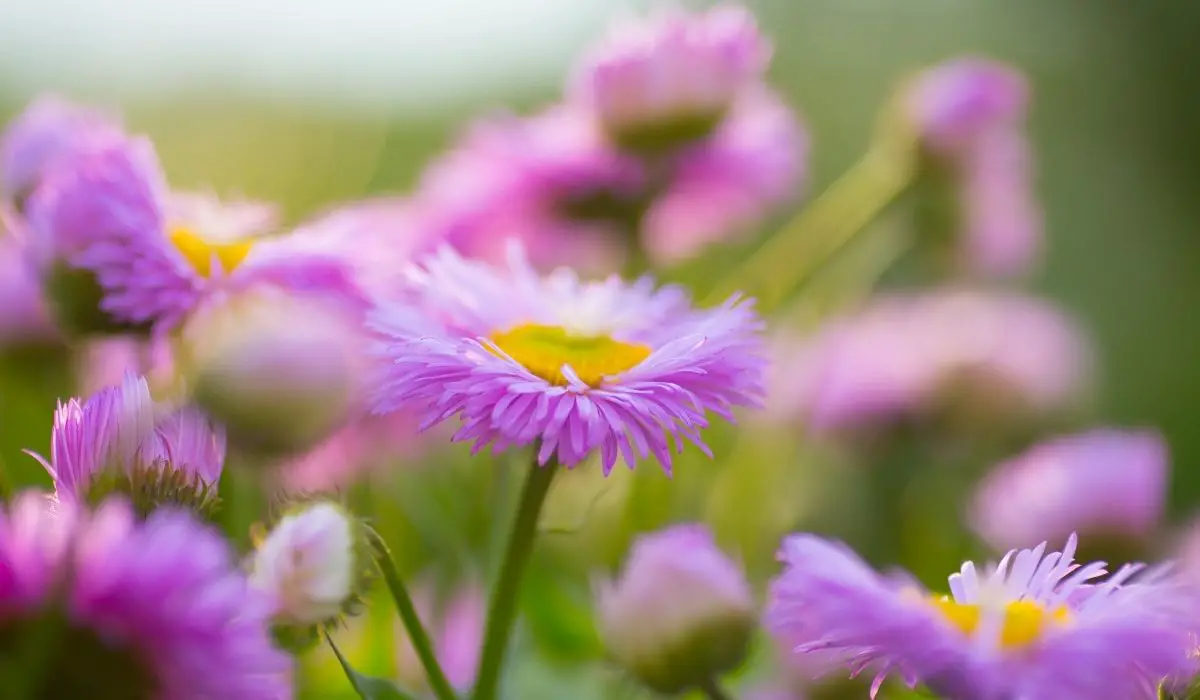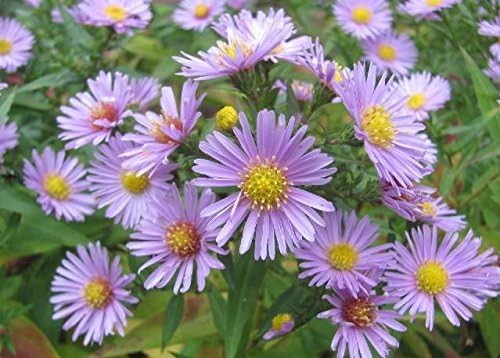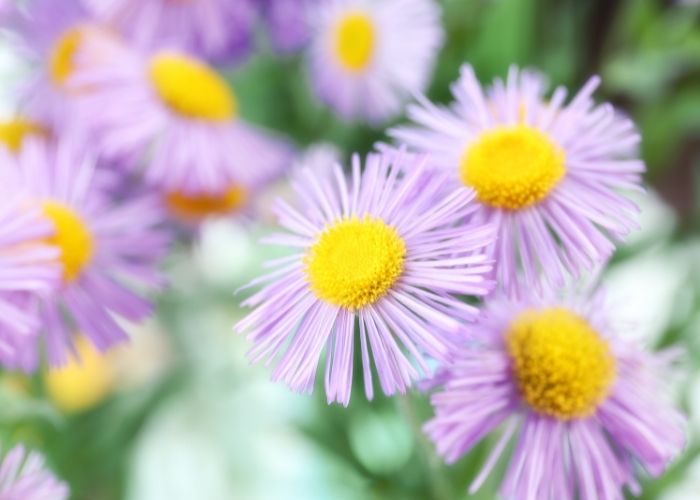Last Updated on December 30, 2022 by Griselda M.
Are asters perennials or annuals, or in what classification do you place these adorable flowers that fill your garden with beautiful blooms?
Aster’s daisy-like flowers bloom in late summer or early fall and are easy to grow and bloom reliably. They are available in a wide variety of colors and sizes. There is a massive attraction to pollinators due to their brightly colored flowers and they’re highly disease-resistant.
So Are Asters Annuals Or Perennials
Asters are fall-blooming perennials that you will love. This hardy plant comes in shades of pink, purple, blue, or lavender. They are unique because they start blooming when everything else in the garden is looking tired and shaggy.
Asters are a beautiful alternative or companion to other flowers. Aster flowers score high in the autumn garden because of all the rich colors they come in. For those who want to keep their garden full of color late in the year as winter approaches, these flowers are an invaluable plant to grow.
So, if anyone asks you, is aster a perennial? Give them a resounding yes with a big smile.
What Kind Of Asters Should You Plant – Annuals Or Perennials?
Asters come in a variety of heights ranging from 12 inches to four feet, and they work best in the back or front of borders, depending on their size. They can be planted in USDA hardiness zones 3 to 8.
Some varieties are tall and stately, with others carrying a more mounded shape. They require full sun with at least 6 hours of direct sunlight.
When grown in too much shade, they get leggy and floppy and do not blow me well. Asters usually bloom for weeks, starting from early to late fall.
When Should You Plant Asters?
Plant your asters in the spring so they can bloom in the fall season. For late-season planting, you can purchase them already in bloom for the fall color.
The plants will more likely return next year as long as you get them in the ground at least 6 to 8 weeks before freezing begins.
Perennial Aster Species You Can Plant In Your Garden
Perennial asters from the aster, symphyotrichum, and stokesia are all Asteraceae or the daisy family.
There are numerous perennial types available with colorful daisy-like blossoms and shrub plants.
Aromatic
The aromatic aster is a medium-sized native species with a mature height of about 1 to 3 feet and an equal spread.
This plant has a compact growth habit with stiff stems and branching that gives it a bushy appearance. The lower portions turn woody and brown in the fall. Its leaves may range from dark green to yellowish. The leaves have smooth margins, significant at the bottom and smaller near the top of the stem.
The flowers have violet-blue rays with yellow center discs. They are approximately 1 and 1/4 inches across and clustered at the ends of the branches. Their centers turn reddish-purple as they age.
Blue Wood
Blue wood, also known as heart-leaved aster, is a native species with a mature height of approximately 2 to 5 ft. Its width range from about 18 to 24 inches. The upright stems mature to reddish-brown and are heavily filled with blossoms.
This type tends to grow leggy and requires staking. Its leaves are prominently serrated and covered in sparse hair. The lower foliage is heart-shaped and more extensive than the upper leaves, which weather and drop by late summer.
The blooms have pale to bright blue rays around the yellow center discs measuring about 3/4 of an inch across.
Calico
Calico or side flying star is a medium-sized species that generally grows to about 2 to 3 feet tall with an equal width spread.
It has a bushy growth habit with hairy stems and matures to red-brown color. It has horizontal branching that requires staking in some cases.
The calico plant has bronze foliage in the fall. Its leaves are roughly textured, narrow, and can be hairy. They are more significant at the bottom, gradually becoming smaller towards the top of the stem. The leaves may have some solution to the margins.
Its flowers have white rays tinged with purple, measuring 1/2 to 1/3 of an inch across. The center discs are yellow, maturing to reddish-purple. The blossoms are clustered in an upright panicle along the uppermost side of each stem, and this pattern gives this variety its alternative name, side flowering.
Frost
The frost or hairy aster is a native species that grows to mature dimensions between 2 and 4 feet wide. It has hairy stems and a clumping growth habit. Its sturdy straight stems darken to become Woody and brown. These plants require support as they grow older.
The leaves are hairy with a lance shape with slightly smooth margins. The leaves at the bottom are more prominent and tend to drop off when the soil becomes very dry.
The flowers are white race surrounded by pale yellow center discs that mature to reddish-purple color. They measure around 3/4 of an inch in diameter and are loosely clustered at the top of the stems.
New England
The New England storm is a tall native species that grows to at least 3 to 6 feet tall with a spread of about 2 to 3 feet wide. Its thick hairy stems are upright and non-branching and have hairy lance-shaped lines in the stems. It is necessary to stake this type so that it does not fall over as it grows.
Its flowers have rays of purple-pink, violet-blue or white clusters growing in dense cone-shaped panicles at the top of the stems. The flowers measure 1 1/4 inches wide with yellow center discs.
The New England asters are best grown in open spaces, so they have room to spread, such as property perimeters.
New York
The New York aster is a native species that grows up to 3 to 6 feet high and two to three feet wide. It has an upright growth habit with thinner stems than those of the New England species. Given the height of the stems, it requires staking.
The leaves are smooth, grey-green, and lance-shaped with slightly serrated margins. The flowers are deep pink or purple-red clusters in dense panicles. They have a yellow disc center and measure about one and a quarter inches across the width.
Are Aster Flowers Poisonous?
If you’re wondering, if are aster flowers poisonous, the answer is no they are not. These plants are quite safe around dogs, cats, livestock, and humans who actually consume the flowers. The flowers can be eaten in various ways which include adding them to salads or using them to make a fresh cup of tea.
These plants also have medicinal value and are therefore often used to manage cold and flu symptoms in many parts of the world. This is due to the aster flowers’ diaphoretic action when infused in hot water to make tea. So there you have it! Aster flowers are not harmful at all as they are a benefit when grown in your garden.
What Eats Aster Flowers?
Do you have asters growing in your garden and want to find out what eats aster flowers? If so, then pay careful attention to the following information. When it comes to asters, the first thing to look out for if they are getting eaten is pests. This is because these little critters can prove harmful to your aster plants if left undetected over time.
The two main culprits, in this case, are lace bugs and spider mites as they enjoy eating asters while giving the flowers a flawed appearance. Other common aster flower eaters include leafhoppers, leaf miners, soft scales, caterpillars, and thrips. Rabbits are another culprit who finds the texture and taste of aster flowers quite irresistible, so look out for them also.
Where Does The Aster Flower Grow?
Ever thought about where the aster flower grows best? These plants grow best in well-drained loamy soils that are rich in nutrients and prefer grasslands. Aster flowers also favor seashore breezes and these plants actually thrive in coastal regions because of the cool misty air. When given dappled or partial shade, you can expect to see abundant blooms from your aster plant, provided that all their other demands are timeously met.
For these plants to continue blooming, deadheading them regularly is recommended. Additionally, during the late autumn season, pruning them would be ideal, just as pinching the flowering tips in the spring season will increase their yield.
How Do You Collect Aster Flower Seeds?
If you want to know how you collect aster flower seeds, then this information is for you. For aster seed collection, you can opt for one of the following methods. These include stalk harvesting, flower head snipping, or seed head crumbling. To begin the aster flower seed collection, ensure that you put on a pair of garden gloves to avoid mishaps. Thereafter, choose from one of the strategies below to get on with your endeavor.
The Stalk Harvesting Method
To do this, you will be required to cut an entire stalk that embodies blossoms in clusters. Harvesting the seeds before the arrival of the first frost is advised as it will prevent your aster plant from becoming mushy.
The Flower Head Snipping Method
This involves snipping off individual flowers rather than clusters. If you opt for this method, just keep in mind that it may be a little more time-consuming than stalk harvesting your aster flower seeds. However, you would have to only pluck the dried flower heads in this case as they become available on the tree. So, patience should be practiced if you opt to go this route.
The Seed Head Crumbling Method
This method is super easy as all it requires is for you to bag the blooms while it is still on the plant and crumble them using your fingers. This will release the seed from the dried flowers which will fall directly into the bag. Be careful to steer clear from fresh blooms when doing this as you wouldn’t want to cause any damage to your aster flowers. Therefore, crumbling the flowers as they become dry is advised.
Conclusion
Asters annuals or perennials? you choose to either grow them afresh each year or leave them in the ground in winter for regrowth in the coming season.
Asters are well known for their exceptionally long vase life. It is beautiful to pick them, and put them in a vase, allowing them to brighten your house in the fall.
If you strip all the leaves below the waterline, thin out the leaves up to the stem a bit more, and add a little vinegar in the water, maximizing the cut-flower potential.
When arranging your flowers, you can mix the rich purple and magenta colors with leaf flowering types – hydrangeas, sparky, and bright foliage for that perfect combo.
Next up, find out all about When To Cut Back Spiderwort.
Caroline is a gardener who loves to get down to the nitty–gritty of gardening. She proudly proclaims herself as a ‘dirt worshipper‘ and can often be found deep in the garden, covered in soil and singing to her plants. As a self–proclaimed ‘plant whisperer‘, Caroline believes that plants need love and attention just like any other living thing, and she loves to give them both. When she‘s not tending to her garden, you can often find her researching the latest gardening trends, or teaching others how to make their gardens thrive



